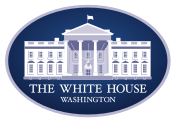White House Press Secretary
| White House Press Secretary | |
|---|---|
 |
|
| Office of the Press Secretary | |
| Appointer | President of the United States |
| Formation | 1929 |
| First holder | George Edward Akerson |
| Website | www |
The White House Press Secretary is a senior White House official whose primary responsibility is to act as spokesperson for the United States government administration, especially with regard to the President, senior executives, and policies.
The press secretary is responsible for collecting information about actions and events within the president's administration and issues the administration's reactions to developments around the world. The press secretary interacts with the media, and deals with the White House press corps on a daily basis, generally in a daily press briefing.
The press secretary serves by the appointment of and at the pleasure of the president; the office does not require the advice and consent of the U.S. Senate, though because of the frequent briefings given to the media, who in turn inform the public, the position is still a very prominent non-Cabinet post.
During the United States' somewhat early years, the White House staff or various White House Offices were not as robust as they are today and there was not a single designated staff person or office responsible for managing the relationship between the president and the growing number of journalists and media entities that were covering him. It was not until after President Abraham Lincoln's administration that Congress formally appropriated funds for a White House Staff, which at first consisted merely of a Secretary.Ulysses S. Grant's White House Staff officially numbered six people at a cost of $13,800, though he supplemented with personnel from the War Department. Fifty years later under the Coolidge Administration, the staff had increased to just fewer than fifty people at a cost of nearly $100,000.
As presidents increasingly hired more staff to support them in the execution of their duties, some showed a tendency to pick aides and confidantes who had backgrounds in the field of journalism. One of Abraham Lincoln's private secretaries, John G. Nicolay, had been an editor and owner of a newspaper in Illinois before he worked for the President in the White House. While the modern equivalent of a private or personal secretary to the President of the United States would be more narrowly concerned with the care and feeding of the president, the small size of the White House staff at that point meant that Nicolay interacted with the press occasionally in carrying out his duties. He was occasionally asked to verify stories or information that various members of the press had heard. Though the title and establishment of the roles and responsibilities of the press secretary job was still decades in the future, the small and growing White House staff was increasingly interacting with a growing number of professional journalists and mass media entities covering the president and the White House.Andrew Johnson was the first president to grant a formal interview request to a reporter, sitting down with Col. Alexander K. McClure from Pennsylvania. It should be noted that while various presidents and reporters had participated in conversations or dialogues prior to Johnson, the exchanges had been less formal.
...
Wikipedia

